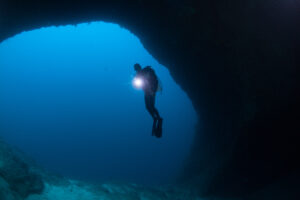What is Buddy Breathing?
Buddy breathing is a vital emergency procedure in scuba diving that involves the sharing of a single air supply by two or more divers when one diver’s air supply is exhausted or unavailable due to equipment malfunction. This life-saving technique is an essential component of scuba diving training and serves as a critical safety measure in the underwater environment.
History and Evolution of Buddy Breathing
The concept of buddy breathing dates back to the early days of scuba diving in the 1940s and 1950s. Jacques-Yves Cousteau and Emile Gagnan, the inventors of the Aqua-Lung, recognized the need for a system that allowed divers to share air in case of emergency. They designed the first double-hose regulator, which made buddy breathing possible by allowing divers to switch the mouthpiece between them.
Over the years, advancements in diving technology led to the development of single-hose regulators, which have become the standard in modern scuba diving. Although buddy breathing with single-hose regulators is more challenging than with double-hose regulators, the technique remains an essential skill for divers.
Buddy Breathing Techniques
To effectively perform buddy breathing, divers must be familiar with the necessary techniques and protocols. The following steps outline the standard buddy breathing procedure using a single-hose regulator:
Recognition
In case of an emergency, the diver experiencing air supply issues should communicate their problem to their dive buddy using the international hand signal for “out of air” (a hand slicing across the throat).
Approach
The dive buddy should calmly approach the distressed diver, taking care not to create panic or worsen the situation.
Donation
The dive buddy donates their primary second-stage regulator (the mouthpiece they are breathing from) to the distressed diver, ensuring they have a reliable air supply.
Alternate Air Source
The dive buddy retrieves their alternate air source, typically a bright yellow second-stage regulator, and begins breathing from it.
Physical Contact
The divers maintain physical contact, often holding onto each other’s BCD (buoyancy control device) or harness to prevent separation.
Exhalation
Divers take turns inhaling and exhaling, each waiting for their partner to finish a full breath before switching the regulator between them. Proper communication and coordination are crucial in this process.
Ascent
The divers carefully and slowly ascend to the surface, maintaining the proper ascent rate to avoid decompression sickness or other complications.
Surface Communication
Once at the surface, the divers signal for assistance, if necessary, and inform others of the situation.
It is important to note that buddy breathing should be practiced and mastered in a controlled environment, such as a swimming pool, under the guidance of a certified scuba instructor before attempting it in open water.
Alternative Emergency Air Sharing Devices
Modern scuba diving equipment has evolved to include alternative emergency air sharing devices that are designed to simplify the process of sharing air between divers. Some of these devices include:
Octopus Regulator
A secondary second-stage regulator, typically colored bright yellow for easy identification, attached to the primary first-stage regulator. This device allows the distressed diver to breathe from the octopus regulator while the dive buddy continues to breathe from their primary second-stage regulator.
Air2 or Alternate Inflator Regulator (AIR)
A combination of a power inflator for the BCD and a secondary second-stage regulator, allowing divers to share air without having to switch their primary regulators.
Pony Bottle
A small, independent air cylinder with its regulator, used as a backup air supply. In an emergency, the distressed diver can switch to the pony bottle, eliminating the need for buddy breathing.
Although these devices offer more convenient and efficient alternatives to buddy breathing, it is essential for divers to remain proficient in the traditional buddy breathing technique, as it may still be required in certain situations where alternative devices are not available or have malfunctioned.
The Importance of Buddy Checks and Equipment Maintenance
Buddy breathing serves as a last resort in emergencies, and its necessity can often be prevented by proper equipment maintenance and pre-dive buddy checks. Divers should always inspect their equipment before each dive and regularly service their gear according to the manufacturer’s recommendations. Additionally, conducting a thorough buddy check before entering the water can help identify potential issues and ensure that both divers are familiar with each other’s equipment.
A standard buddy check includes inspecting each diver’s BCD, regulator, alternate air source, and other essential gear. Divers should also review hand signals, emergency procedures, and dive plan to foster clear communication and understanding between dive partners.
The Role of Buddy Breathing in Dive Training
Buddy breathing is a fundamental skill taught in most scuba diving certification courses, including the entry-level Open Water Diver course offered by various training agencies such as PADI, SSI, and NAUI. Mastering buddy breathing is crucial for divers to become competent and responsible dive partners, ensuring the safety of themselves and others in the underwater environment.
In addition to learning buddy breathing techniques, dive training courses also emphasize the importance of proper equipment maintenance, buddy checks, and other safety procedures. These comprehensive training programs prepare divers to handle various underwater emergencies and promote a culture of safety within the diving community.
Key Takeaways
Buddy breathing is an essential emergency procedure in scuba diving that can be lifesaving in situations where a diver’s air supply is compromised. Despite advancements in diving technology and the availability of alternative emergency air sharing devices, buddy breathing remains a critical skill for divers to learn and practice. By mastering buddy breathing, conducting thorough buddy checks, and maintaining equipment properly, divers can significantly reduce the risk of air supply emergencies and enjoy a safer diving experience.

















